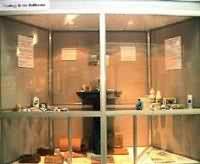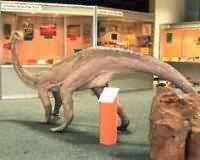|
| |
National Earth Science Museum
Open on weekdays
8:00– 13:00 and 14:00 –17:00,
No entrance fee is charged
|
|
The National Earth Science Museum in the Geological Survey is the primary repository of geological specimens in Namibia and houses a large collection of rocks, minerals and fossils.
|
 |
The economic mineral deposits of Namibia are represented by displays of various operating mines and exploration prospects;
-
Tsumeb poly-metallic deposit
-
Kombat copper/lead/silver
-
Rössing alaskite uranium
-
Navachab skarn gold
-
Otjihase copper/pyrite
-
Rosh Pinah lead/zinc
-
and Huab porphyry copper prospect
|
The world famous Tsumeb poly-metallic ore body
(Pb, Cu, Zn, Ag, As,
Sb, Cd, Co, Ge, Ga, Fe, Hg, Mo, Ni, Sn, W, V) hosts some 226 minerals, 40 of which are unique to Tsumeb.
Following the closure of the mine in 1996 and the liquidation of the parent company in 1998, the Tsumeb collection was donated to the nation by Gold Fields Namibia Limited and
forms the basis of an outstanding mineral collection that also includes a variety of semi-precious stones found in
Namibia.
|
The industrial minerals displays illustrate their varied, and
often unknown, uses by showing the raw minerals together with products derived from them. These include;
-
in the bathroom (ceramics, toiletries, detergents etc.)
-
vehicle production (plastics, paint, etc.)
-
clays (ceramics, bricks, pottery, etc.)
|
 |
Namcor, Namibia's oil and gas parastatal, has displays on the hydrocarbon exploration and development, including the 2.0 trillion cubic feet Kudu Gas Fields (off-shore
southern Namibia) which is currently in final feasibility stage.
|
 |
The most extensive meteorite shower on earth is found in southern Namibia near the village of Gibeon. The meteorites are classified as octahedrites and consist entirely of taenite and
kamacite in a classical Widmanstatten structure. A total of 77 pieces have been found to date and as they have almost identical compositions they are thought to initially been part of one large 15 ton body. |
| The largest fragment
weighs 650 kg and is housed in the South African Museum, Cape Town. Some 33 of these are exhibited in Windhoek’s Post Street Mall as the "Gibeon Meteorite Fountain" and
range from 195kg to 555kg. The smaller fragments are on display in the Geological Survey Museum in Windhoek.
The museum also houses a wide variety of Namibian fossils ranging in age from 750 million years ago to recent. |
|
Our latest display is that of Massospondylus,
a prosauropod dinosaur that lived 200 million years ago. Its fossilised remains were found
in the Etjo sandstone Formation in the Waterberg National Park in 1997 by Frank Holzfoerster of Institut fuer
Geologie, University of Wuerzburg, Germany and later identified by Dr
Bruce Rubridge and Dr Mike Raath of BPI
Palaeontology, University of the Witwatersrand, South Africa.
|
 |
Some other paleontological highlights are;
-
750-650 year old Stromatolites,
-
Pteridinium specimens from the Nama Group,
-
the earliest known shell-bearing organism, Cloudina,
-
a basal Archosaur (Family Erythrosuchidae) from the Omingonde Formation. This animal lived about 230 million years ago and the group it represents eventually gave rise to
the dinosaurs, crocodiles and birds,
-
various mammal like reptilian Karoo fossils, also from the Omingonde Formation, that are morphologically transitional forms between reptiles and
mammals,
-
more recent fossils include the Arrisdrift collection from southern Namibia with an age of 17-19,5 million years. Found on the northern bank of the Orange River, fossils collected
from this site include a big type of dassie, crocodiles, small rodents, rhinoceros, ancient species of elephant, giraffe ancestors and fish,
-
from the Namib Desert, fossilised eggshells of extinct ostrich and plenty of fossilised animal burrows,
-
and the lower jaw of Otavipithicus namibiensis, the first fossil ape ever found in the Southern Hemisphere with an age of about 13 million years.
|
|